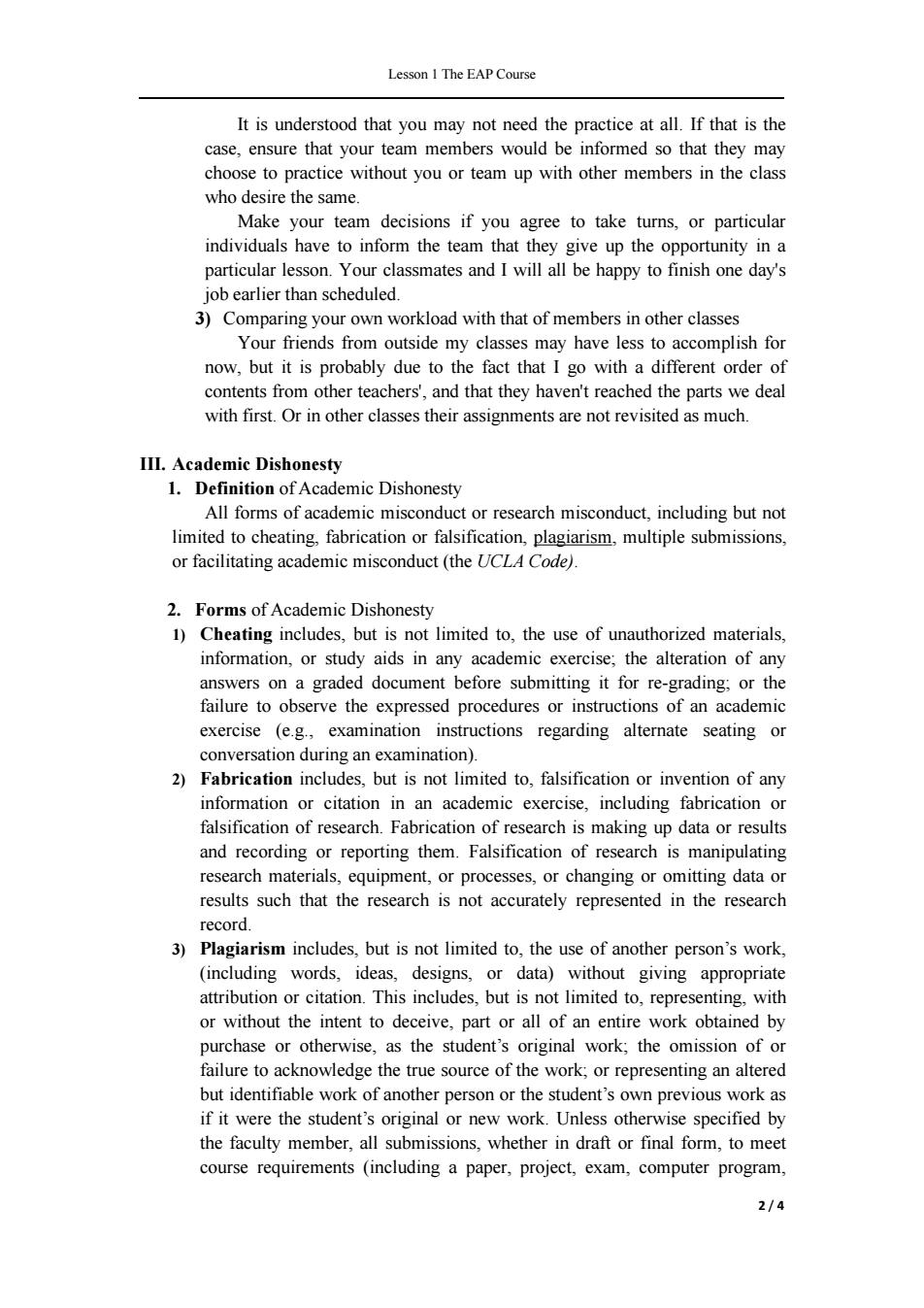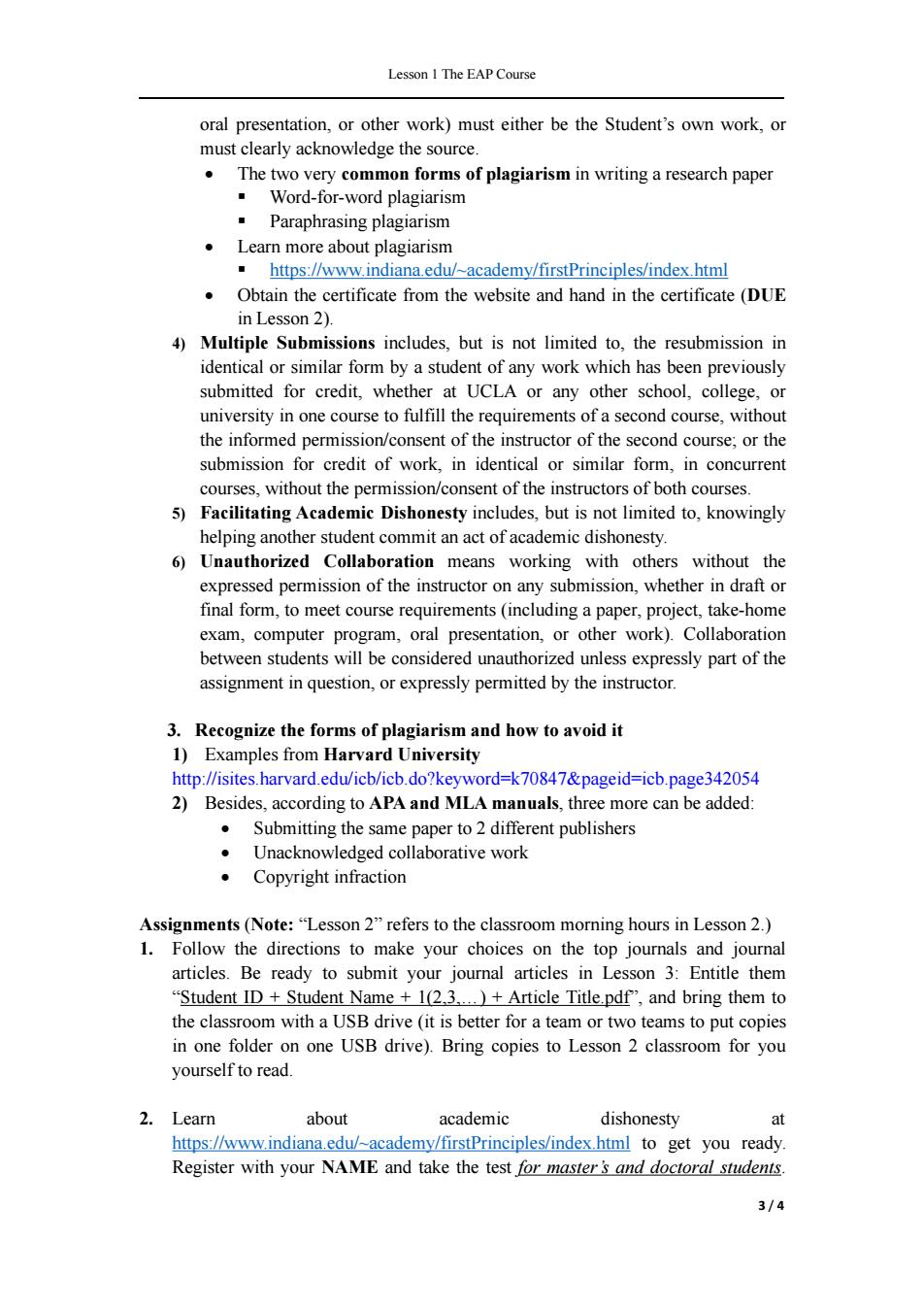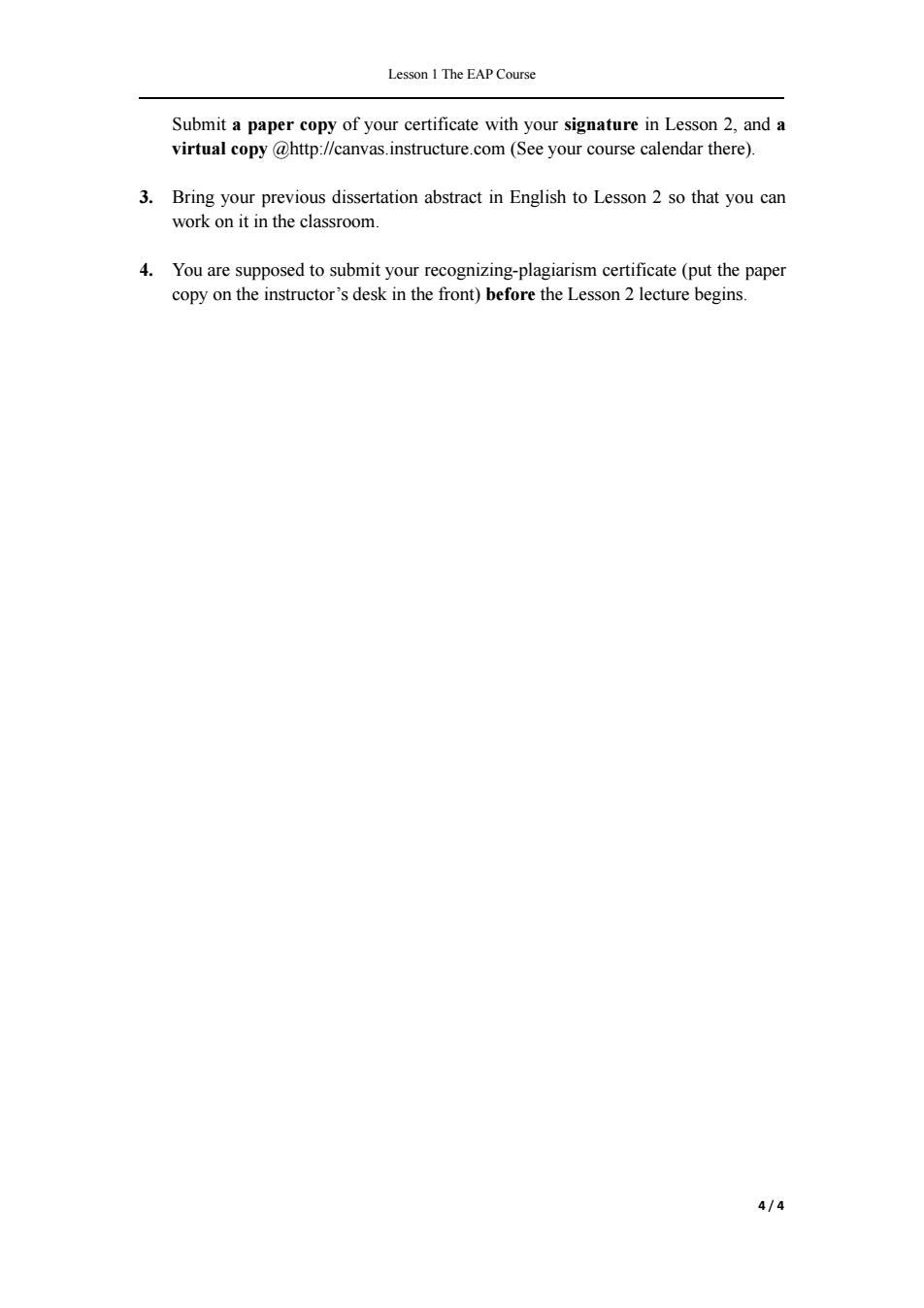
Lesson 1 The EAP Course Lesson 1 Course of English for Academic Purposes I.The Syllabus:the Focuses 1.Performance Grade Preparedness for classroom ·Mini-talk 2min./talk Summary (Critique),or dubbing on a TED/state-of-the-art research 2 talks/week,from Lesson 4 on Prevision Revision and assignments revisited Raising thought-provoking questions during lectures Responses in classroom tasks and idea contribution during lectures Enthusiasm in course projects Submitted formative and optional assignments 2.Three or more journal articles by native English speaker authors in top journals in your sub-discipline consult your supervisor on journals justify your choice(s)on journals in portable document format(as.pdf) to be submitted as required to the class database(DUE in Lesson 3) virtual and/or paper copies to be brought to the classroom (Lesson 2>) partially as your textbook for EAP as evidence to justify your approach in writing research papers 3.Check your understanding of the syllabus II.Course-Taking Need-to-Know 1.Introspection,initiative,and perspective E.g.:Course-takers'advice on previewing the lessons Teamwork 2.Logical train of thinking /Structural thinking 3.Teamwork 4.Coping with the workload The course itself is designed to be challenging but in the end rewarding. 1)Taking the opportunities Opportunities are offered for all,but whether to take them(except for L3 and final presentations)depends on how much you plan to improve your performance in the final team presentation(total=15%,and requirements are strict).Co-ordination (not restricted as between team members,but to cover everything in order for the success of your presentation/talk/report)could be achieved only through constant practice. 2)Keeping your team updated 1/4
Lesson 1 The EAP Course 1 / 4 Lesson 1 Course of English for Academic Purposes I. The Syllabus: the Focuses 1. Performance Grade Preparedness for classroom Mini-talk 2min./talk Summary (+ Critique), or dubbing on a TED/state-of-the-art research 2 talks/week, from Lesson 4 on Prevision Revision and assignments revisited Raising thought-provoking questions during lectures Responses in classroom tasks and idea contribution during lectures Enthusiasm in course projects Submitted formative and optional assignments 2. Three or more journal articles by native English speaker authors in top journals in your sub-discipline consult your supervisor on journals justify your choice(s) on journals in portable document format (as .pdf) to be submitted as required to the class database (DUE in Lesson 3) virtual and/or paper copies to be brought to the classroom (Lesson 2 ) partially as your textbook for EAP as evidence to justify your approach in writing research papers 3. Check your understanding of the syllabus II. Course-Taking Need-to-Know 1. Introspection, initiative, and perspective E.g.: Course-takers’ advice on previewing the lessons & Teamwork 2. Logical train of thinking / Structural thinking 3. Teamwork 4. Coping with the workload The course itself is designed to be challenging but in the end rewarding. 1) Taking the opportunities Opportunities are offered for all, but whether to take them (except for L3 and final presentations) depends on how much you plan to improve your performance in the final team presentation (total = 15%, and requirements are strict). Co-ordination (not restricted as between team members, but to cover everything in order for the success of your presentation/talk/report) could be achieved only through constant practice. 2) Keeping your team updated

Lesson 1 The EAP Course It is understood that you may not need the practice at all.If that is the case,ensure that your team members would be informed so that they may choose to practice without you or team up with other members in the class who desire the same. Make your team decisions if you agree to take turns,or particular individuals have to inform the team that they give up the opportunity in a particular lesson.Your classmates and I will all be happy to finish one day's job earlier than scheduled. 3)Comparing your own workload with that of members in other classes Your friends from outside my classes may have less to accomplish for now,but it is probably due to the fact that I go with a different order of contents from other teachers',and that they haven't reached the parts we deal with first.Or in other classes their assignments are not revisited as much. III.Academic Dishonesty 1.Definition of Academic Dishonesty All forms of academic misconduct or research misconduct,including but not limited to cheating,fabrication or falsification,plagiarism,multiple submissions, or facilitating academic misconduct (the UCLA Code). 2.Forms of Academic Dishonesty 1)Cheating includes,but is not limited to,the use of unauthorized materials, information,or study aids in any academic exercise;the alteration of any answers on a graded document before submitting it for re-grading;or the failure to observe the expressed procedures or instructions of an academic exercise (e.g.,examination instructions regarding alternate seating or conversation during an examination). 2)Fabrication includes,but is not limited to,falsification or invention of any information or citation in an academic exercise,including fabrication or falsification of research.Fabrication of research is making up data or results and recording or reporting them.Falsification of research is manipulating research materials,equipment,or processes,or changing or omitting data or results such that the research is not accurately represented in the research record. 3)Plagiarism includes,but is not limited to,the use of another person's work, (including words,ideas,designs,or data)without giving appropriate attribution or citation.This includes,but is not limited to,representing,with or without the intent to deceive,part or all of an entire work obtained by purchase or otherwise,as the student's original work;the omission of or failure to acknowledge the true source of the work;or representing an altered but identifiable work of another person or the student's own previous work as if it were the student's original or new work.Unless otherwise specified by the faculty member,all submissions,whether in draft or final form,to meet course requirements (including a paper,project,exam,computer program, 2/4
Lesson 1 The EAP Course 2 / 4 It is understood that you may not need the practice at all. If that is the case, ensure that your team members would be informed so that they may choose to practice without you or team up with other members in the class who desire the same. Make your team decisions if you agree to take turns, or particular individuals have to inform the team that they give up the opportunity in a particular lesson. Your classmates and I will all be happy to finish one day's job earlier than scheduled. 3) Comparing your own workload with that of members in other classes Your friends from outside my classes may have less to accomplish for now, but it is probably due to the fact that I go with a different order of contents from other teachers', and that they haven't reached the parts we deal with first. Or in other classes their assignments are not revisited as much. III. Academic Dishonesty 1. Definition of Academic Dishonesty All forms of academic misconduct or research misconduct, including but not limited to cheating, fabrication or falsification, plagiarism, multiple submissions, or facilitating academic misconduct (the UCLA Code). 2. Forms of Academic Dishonesty 1) Cheating includes, but is not limited to, the use of unauthorized materials, information, or study aids in any academic exercise; the alteration of any answers on a graded document before submitting it for re-grading; or the failure to observe the expressed procedures or instructions of an academic exercise (e.g., examination instructions regarding alternate seating or conversation during an examination). 2) Fabrication includes, but is not limited to, falsification or invention of any information or citation in an academic exercise, including fabrication or falsification of research. Fabrication of research is making up data or results and recording or reporting them. Falsification of research is manipulating research materials, equipment, or processes, or changing or omitting data or results such that the research is not accurately represented in the research record. 3) Plagiarism includes, but is not limited to, the use of another person’s work, (including words, ideas, designs, or data) without giving appropriate attribution or citation. This includes, but is not limited to, representing, with or without the intent to deceive, part or all of an entire work obtained by purchase or otherwise, as the student’s original work; the omission of or failure to acknowledge the true source of the work; or representing an altered but identifiable work of another person or the student’s own previous work as if it were the student’s original or new work. Unless otherwise specified by the faculty member, all submissions, whether in draft or final form, to meet course requirements (including a paper, project, exam, computer program

Lesson 1 The EAP Course oral presentation,or other work)must either be the Student's own work,or must clearly acknowledge the source. The two very common forms of plagiarism in writing a research paper Word-for-word plagiarism Paraphrasing plagiarism Learn more about plagiarism https://www.indiana.edu/-academy/firstPrinciples/index.html Obtain the certificate from the website and hand in the certificate (DUE in Lesson 2). 4)Multiple Submissions includes,but is not limited to,the resubmission in identical or similar form by a student of any work which has been previously submitted for credit,whether at UCLA or any other school,college,or university in one course to fulfill the requirements of a second course,without the informed permission/consent of the instructor of the second course;or the submission for credit of work,in identical or similar form,in concurrent courses,without the permission/consent of the instructors of both courses. 5)Facilitating Academic Dishonesty includes,but is not limited to,knowingly helping another student commit an act of academic dishonesty. 6)Unauthorized Collaboration means working with others without the expressed permission of the instructor on any submission,whether in draft or final form,to meet course requirements(including a paper,project,take-home exam,computer program,oral presentation,or other work).Collaboration between students will be considered unauthorized unless expressly part of the assignment in question,or expressly permitted by the instructor. 3.Recognize the forms of plagiarism and how to avoid it 1)Examples from Harvard University http://isites.harvard.edu/icb/icb.do?keyword=k70847&pageid=icb.page342054 2)Besides,according to APA and MLA manuals,three more can be added: Submitting the same paper to 2 different publishers Unacknowledged collaborative work Copyright infraction Assignments(Note:"Lesson 2"refers to the classroom morning hours in Lesson 2.) 1.Follow the directions to make your choices on the top journals and journal articles.Be ready to submit your journal articles in Lesson 3:Entitle them "Student ID Student Name 1(2.3...)+Article Title.pdf",and bring them to the classroom with a USB drive (it is better for a team or two teams to put copies in one folder on one USB drive).Bring copies to Lesson 2 classroom for you yourself to read. 2.Learn about academic dishonesty at https://www.indiana.edu/-academy/firstPrinciples/index.html to get you ready. Register with your NAME and take the test for master's and doctoral students. 3/4
Lesson 1 The EAP Course 3 / 4 oral presentation, or other work) must either be the Student’s own work, or must clearly acknowledge the source. The two very common forms of plagiarism in writing a research paper Word-for-word plagiarism Paraphrasing plagiarism Learn more about plagiarism https://www.indiana.edu/~academy/firstPrinciples/index.html Obtain the certificate from the website and hand in the certificate (DUE in Lesson 2). 4) Multiple Submissions includes, but is not limited to, the resubmission in identical or similar form by a student of any work which has been previously submitted for credit, whether at UCLA or any other school, college, or university in one course to fulfill the requirements of a second course, without the informed permission/consent of the instructor of the second course; or the submission for credit of work, in identical or similar form, in concurrent courses, without the permission/consent of the instructors of both courses. 5) Facilitating Academic Dishonesty includes, but is not limited to, knowingly helping another student commit an act of academic dishonesty. 6) Unauthorized Collaboration means working with others without the expressed permission of the instructor on any submission, whether in draft or final form, to meet course requirements (including a paper, project, take-home exam, computer program, oral presentation, or other work). Collaboration between students will be considered unauthorized unless expressly part of the assignment in question, or expressly permitted by the instructor. 3. Recognize the forms of plagiarism and how to avoid it 1) Examples from Harvard University http://isites.harvard.edu/icb/icb.do?keyword=k70847&pageid=icb.page342054 2) Besides, according to APA and MLA manuals, three more can be added: Submitting the same paper to 2 different publishers Unacknowledged collaborative work Copyright infraction Assignments (Note: “Lesson 2” refers to the classroom morning hours in Lesson 2.) 1. Follow the directions to make your choices on the top journals and journal articles. Be ready to submit your journal articles in Lesson 3: Entitle them “Student ID + Student Name + 1(2,3,…) + Article Title.pdf”, and bring them to the classroom with a USB drive (it is better for a team or two teams to put copies in one folder on one USB drive). Bring copies to Lesson 2 classroom for you yourself to read. 2. Learn about academic dishonesty at https://www.indiana.edu/~academy/firstPrinciples/index.html to get you ready. Register with your NAME and take the test for master’s and doctoral students

Lesson 1 The EAP Course Submit a paper copy of your certificate with your signature in Lesson 2,and a virtual copy @http://canvas.instructure.com(See your course calendar there). 3.Bring your previous dissertation abstract in English to Lesson 2 so that you can work on it in the classroom. 4.You are supposed to submit your recognizing-plagiarism certificate(put the paper copy on the instructor's desk in the front)before the Lesson 2 lecture begins. 4/4
Lesson 1 The EAP Course 4 / 4 Submit a paper copy of your certificate with your signature in Lesson 2, and a virtual copy @http://canvas.instructure.com (See your course calendar there). 3. Bring your previous dissertation abstract in English to Lesson 2 so that you can work on it in the classroom. 4. You are supposed to submit your recognizing-plagiarism certificate (put the paper copy on the instructor’s desk in the front) before the Lesson 2 lecture begins